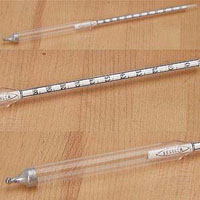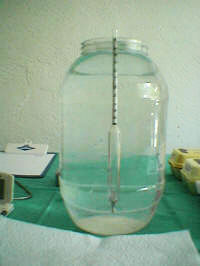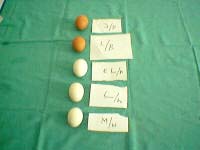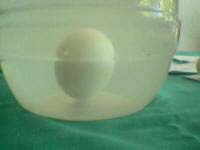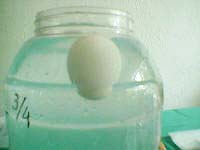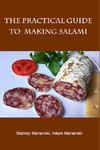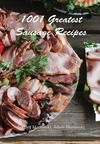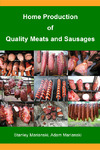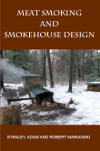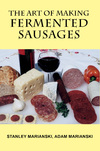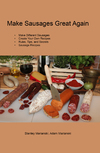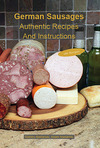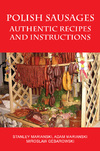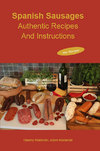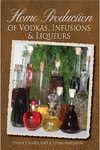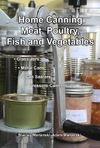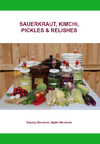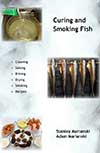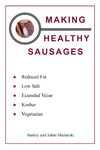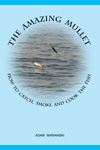Meats and Sausages
Making Brine
There isn’t a universal brine, and every book and recipe provides customized instructions. Salt of different densities and weights (table salt, Morton® Kosher, Diamond® Kosher) is measured with different instruments such as spoons, cups, ounces, pounds, and kilograms. Water measured by cups, quarts, gallons, liters… a total mess and chaos.
The advantage of making your brine is that you have total control, and there is no guessing involved. Firstly, it makes no sense at all to talk about curing time if we don’t specify the strength of a brine. We can mix 2 cups salt with one gallon of water, or we can add 5 cups salt into one gallon of water, and curing times will be different though both brines will do the job. Just two items are needed for professionally preparing brine without depending on unverified recipes or information:
1. Buy a brine tester. They are so cheap that there is no excuse for not having one. The salinometer or salometer (brinometer) consists of a float with an attached stem marked in degrees. The instrument will float at its highest level in a saturated brine displaying 100 degrees (26.4 % salt solution). This is known as a fully saturated brine at 60° F. In weaker brines, the stem will float at lower levels, and the reading will be lower. With no salt present, the reading will be 0. To make the brine, put some water into a suitable container, add some salt, insert a brine tester, and read the scale. Want a stronger solution: add more salt. Need weaker brine: add more water, it is that simple. Keep in mind that a salinometer’s scale measures the density of a solution containing salt and water. Once you add other ingredients the salinometer will measure the density of a solution and not the salinity of the brine.
Brine testers
2. Learn how to use brine tables.
The advantages of using tables are many:
- you can calculate the strength of any recipe you come across
- you can find out how much salt to add to water to create a particular brine strength
- you don’t have to worry whether you use table salt, Morton® kosher salt, or Diamond® kosher salt. Brine Tables are especially useful when making a large volume of brine.
Sodium Chloride (Salt) Brine Tables for Brine at 60 F (15° C) in US Gallons
| Salometer Degrees | Percent of Sodium Chloride (Salt) by Weight | Pounds of Salt per Gallon of Water | Pounds of Salt per Gallon of Brine | Pounds of Water per Gallon of Brine |
|---|---|---|---|---|
| 0 | 0.000 | 0.000 | 0.000 | 8.328 |
| 1 | 0.264 | 0.022 | 0.022 | 8.323 |
| 2 | 0.526 | 0.044 | 0.044 | 8.317 |
| 3 | 0.792 | 0.066 | 0.066 | 8.307 |
| 4 | 1.056 | 0.089 | 0.089 | 8.298 |
| 5 | 1.320 | 0.111 | 0.111 | 8.292 |
| 6 | 1.584 | 0.134 | 0.133 | 8.286 |
| 7 | 1.848 | 0.157 | 0.156 | 8.280 |
| 8 | 2.112 | 0.180 | 0.178 | 8.274 |
| 9 | 2.376 | 0.203 | 0.201 | 8.268 |
| 10 | 2.640 | 0.226 | 0.224 | 8.262 |
| 11 | 2.903 | 0.249 | 0.247 | 8.256 |
| 12 | 3.167 | 0.272 | 0.270 | 8.250 |
| 13 | 3.431 | 0.296 | 0.293 | 8.239 |
| 14 | 3.695 | 0.320 | 0.316 | 8.229 |
| 15 | 3.959 | 0.343 | 0.339 | 8.222 |
| 16 | 4.223 | 0.367 | 0.362 | 8.216 |
| 17 | 4.487 | 0.391 | 0.386 | 8.209 |
| 18 | 4.751 | 0.415 | 0.409 | 8.202 |
| 19 | 5.015 | 0.440 | 0.433 | 8.195 |
| 20 | 5.279 | 0.464 | 0.456 | 8.188 |
| 21 | 5.543 | 0.489 | 0.480 | 8.181 |
| 22 | 5.807 | 0.513 | 0.504 | 8.174 |
| 23 | 6.071 | 0.538 | 0.528 | 8.167 |
| 24 | 6.335 | 0.563 | 0.552 | 8.159 |
| 25 | 6.599 | 0.588 | 0.576 | 8.152 |
| 26 | 6.863 | 0.614 | 0.600 | 8.144 |
| 27 | 7.127 | 0.639 | 0.624 | 8.137 |
| 28 | 7.391 | 0.665 | 0.649 | 8.129 |
| 29 | 7.655 | 0.690 | 0.673 | 8.121 |
| 30 | 7.919 | 0.716 | 0.698 | 8.113 |
| 31 | 8.162 | 0.742 | 0.722 | 8.105 |
| 32 | 8.446 | 0.768 | 0.747 | 8.097 |
| 33 | 8.710 | 0.795 | 0.772 | 8.089 |
| 34 | 8.974 | 0.821 | 0.797 | 8.081 |
| 35 | 9.238 | 0.848 | 0.822 | 8.073 |
| 36 | 9.502 | 0.874 | 0.847 | 8.064 |
| 37 | 9.766 | 0.901 | 0.872 | 8.056 |
| 38 | 10.030 | 0.928 | 0.897 | 8.047 |
| 39 | 10.294 | 0.956 | 0.922 | 8.038 |
| 40 | 10.558 | 0.983 | 0.948 | 8.030 |
| 41 | 10.822 | 1.011 | 0.973 | 8.021 |
| 42 | 11.086 | 1.038 | 0.999 | 8.012 |
| 43 | 11.350 | 1.066 | 1.025 | 8.003 |
| 44 | 11.614 | 1.094 | 1.050 | 7.994 |
| 45 | 11.878 | 1.123 | 1.076 | 7.985 |
| 46 | 12.142 | 1.151 | 1.102 | 7.975 |
| 47 | 12.406 | 1.179 | 1.128 | 7.966 |
| 48 | 12.670 | 1.208 | 1.154 | 7.957 |
| 49 | 12.934 | 1.237 | 1.181 | 7.947 |
| 50 | 13.198 | 1.266 | 1.207 | 7.937 |
| 51 | 13.461 | 1.295 | 1.233 | 7.928 |
| 52 | 13.725 | 1.325 | 1.260 | 7.918 |
| 53 | 13.989 | 1.355 | 1.286 | 7.908 |
| 54 | 14.253 | 1.384 | 1.313 | 7.898 |
| 55 | 14.517 | 1.414 | 1.340 | 7.888 |
| 56 | 14.781 | 1.444 | 1.368 | 7.878 |
| 57 | 15.045 | 1.475 | 1.393 | 7.867 |
| 58 | 15.309 | 1.505 | 1.420 | 7.857 |
| 59 | 15.573 | 1.536 | 1.447 | 7.847 |
| 60 | 15.837 | 1.567 | 1.475 | 7.836 |
| 61 | 16.101 | 1.598 | 1.502 | 7.826 |
| 62 | 16.365 | 1.630 | 1.529 | 7.815 |
| 63 | 16.629 | 1.661 | 1.557 | 7.804 |
| 64 | 16.893 | 1.693 | 1.584 | 7.793 |
| 65 | 17.157 | 1.725 | 1.612 | 7.782 |
| 66 | 17.421 | 1.757 | 1.639 | 7.771 |
| 67 | 17.685 | 1.789 | 1.668 | 7.764 |
| 68 | 17.949 | 1.822 | 1.697 | 7.756 |
| 69 | 18.213 | 1.854 | 1.725 | 7.744 |
| 70 | 18.477 | 1.887 | 1.753 | 7.733 |
| 71 | 18.740 | 1.921 | 1.781 | 7.721 |
| 72 | 19.004 | 1.954 | 1.809 | 7.710 |
| 73 | 19.268 | 1.988 | 1.837 | 7.698 |
| 74 | 19.532 | 2.021 | 1.866 | 7.686 |
| 75 | 19.796 | 2.056 | 1.895 | 7.678 |
| 76 | 20.060 | 2.090 | 1.925 | 7.669 |
| 77 | 20.324 | 2.124 | 1.953 | 7.657 |
| 78 | 20.588 | 2.159 | 1.982 | 7.645 |
| 79 | 20.852 | 2.194 | 2.011 | 7.633 |
| 80 | 21.116 | 2.229 | 2.040 | 7.621 |
| 81 | 21.380 | 2.265 | 2.069 | 7.608 |
| 82 | 21.644 | 2.300 | 2.098 | 7.596 |
| 83 | 21.908 | 2.336 | 2.128 | 7.586 |
| 84 | 22.172 | 2.372 | 2.159 | 7.577 |
| 85 | 22.436 | 2.409 | 2.188 | 7.584 |
| 86 | 22.700 | 2.446 | 2.217 | 7.551 |
| 87 | 22.964 | 2.482 | 2.248 | 7.542 |
| 88 | 23.228 | 2.520 | 2.279 | 7.532 |
| 89 | 23.492 | 2.557 | 2.309 | 7.519 |
| 90 | 23.756 | 2.595 | 2.338 | 7.505 |
| 91 | 24.019 | 2.633 | 2.368 | 7.492 |
| 92 | 24.283 | 2.671 | 2.398 | 7.479 |
| 93 | 24.547 | 2.709 | 2.430 | 7.468 |
| 94 | 24.811 | 2.748 | 2.461 | 7.458 |
| 95 | 25.075 | 2.787 | 2.491 | 7.444 |
| 96 | 25.339 | 2.826 | 2.522 | 7.430 |
| 97 | 25.603 | 2.866 | 2.552 | 7.416 |
| 98 | 25.867 | 2.908 | 2.570 | 7.409 |
| 99 | 26.131 | 2.948 | 2.616 | 7.394 |
| 99.6 | 26.289 | 2.970 | 2.634 | 7.385 |
| 100 | 26.395 | 2.986 | 2.647 | 7.380 |
Seawater contains approximately 3.695 % of salt, which corresponds to 14 degrees salometer.
100 degrees brine is fully saturated and contains 26.395 % of salt. 1 US gallon of water weighs 8.33 lbs
1 US gallon = 3.8 liters = 3.8 kilograms
If you come across a recipe and you would like to determine what is the strength of the brine, just follow two steps:
- Find the percent of salt by weight in the solution: weight of salt/(weight of salt plus weight of water), then multiply the result by 100%
- Look up the tables and find the corresponding salometer degree
For example, let’s find the strength of the brine that is mentioned in many recipes and calls for adding 1 pound of salt to 1 gallon of water (8.33 pounds)
% salt by weight = 1lb of salt/1 lb of salt + 8.33 lbs (1 gallon) of water = 1/9.33 = 0.1071
0.1071 x 100 % = 10.71 % of salt
Looking in the table at Column 2 (percent sodium chloride by weight), we can see that 10.71 % corresponds to 40 ½ degrees.
Another popular brine is made by adding 3/4 cup of salt (219 g) to 1 gallon (3.8 liters)of water
219g / 219 + 3800 g = 0.05
0.05 x 100 = 5 % of salt
Looking in the table at Column 2 (percent sodium chloride by weight) we can see that 5 % corresponds to 19 degrees.
Basic brine is always salt and water; all other ingredients are extras. You can prepare your basic brine using the brine tester, then add all other remaining ingredients, stir them well, and check your reading again to have a reference for the future.
Salinometer readings are calibrated to give a correct indication when the brine is at 60° F temperature. Each brine tester will have its own instructions for temperature compensation but the basic rule of thumb says that for every 10° F the brine is above 60° F, one degree should be added to the reading before using table. If the brine is below 60° F subtract 1 degree for each 10° F from the observed salinometer reading before using tables.
For example, if a salinometer indicates 70 degrees brine and the brine’s temperature is 40° F, the corrected salinometer reading would be 68 degrees (for each 10 F below 60 F, one salinometer degree is subtracted). If the brine temperature is 80° F and the salinometer indicates 40 degrees, the corrected reading would be 82 degrees SAL (for each 10° F above 60° F, one salinometer degree is added). These are very small differences that are of more importance for a meat plant curing huge amounts of meat. Needless to say, a thermometer is needed too.
The Easiest Way to Make Brine
Basically, you have to answer a few questions:
- How much brine - depends on the weight of your meat
- How strong brine - depends on the kind of meat and the intended curing time
- Do you need nitrate/nitrite (Cure1/Cure2)
- Do you need sugar
Let's look at these one at a time:
How Much Brine
The easiest way is to estimate the needed amount of brine. You have to cover the meats and a lot of brine will be wasted if you cure 1 chicken in a filled to the top 55 gallon drum. A basic rule of thumb dictates that the amount (weight) of brine should come to 40-50 % in relation to the weight of the meat. For 2 lbs of meat, use 1 pound of brine. Try to use a container whose size and shape will need little brine to fully cover the meat. In Poland where people have smoked meats for hundreds of years, almost everybody (meats plants included) uses the following weight ratio: from 30 % to 40 % of water to 100 % of meat. That means that for 1 kg (2.2 lbs) of meat, we add 0.4 liters (400 mg) of water. Keep in mind that 1 liter of water weighs exactly 1 kg.
Choose the strength of the brine and keep on adding salt, checking the reading with a salometer. This is a rather time-consuming method, but you can make brine much faster by using tables.
To make brine we need to use only three columns of the table, which are shaded in yellow color.
For example, we want 22 degrees brine to cure chicken. If you follow the 22 degree row to the right, you will see in Column 3 that 0.513 lb of salt has to be added to 1 gallon of water to make 22 degree brine. To make 80 degree brine we need to mix 2.229 lbs of salt with 1 gallon of water. Then check it with your salinometer and add a cup of water or a tablespoon of salt to get a perfect reading. If you end up with not enough brine, make some more. If you think you may need just 1/2 gallon more of 80 degree brine, take 1/2 gallon of water and add 1/2 of salt that the table asks for. In this case looking at 80 degree brine (Column 1), going to the right you can see that in Column 3 the amount of the needed salt is 2.229 lbs. Yes, but this amount is added to 1 gallon of water to create 80 degree brine. Because we use only 1/2 gallon now, this amount of salt needs to be halved: 2.229 lbs/2 = 1.11 lbs. In other words, if we add 1.11 lbs of salt to 1/2 gallon of water, we will also create 80 degree brine.
Let’s say you need about 10 gallons of 60 degrees SAL brine (15.8% salt) to cure ham. Locate 60 degrees SAL in Column 1 and then go across to Column 3 where it is stated that 1.567 pounds salt/gallon of water is needed. Multiplying 1.567 (pounds of salt/gallon of water x 10 gallons of water gives us 15.67 lbs of salt. This is how much salt needs to be added to 10 gallons of water to make 60 degrees SAL brine. Note that you have an increased volume of the solution and it will need a bigger tank than 10 gallons that will hold more than 10 gallons of brine.
When making brine this way, we end up with more brine that requires a 1 gallon container (1 gal of water + salt). There are instances that we may need to make a precise amount of brine that would exactly fit into a certain capacity container. To make exact amounts of brine, use Columns 4 and 5 which are shaded pink in color.
The two columns shaded in pink are used by commercial establishments to make up exact amounts of a particular brine. Let's say that we have a 10 gallon container and before we go fishing we would like to fill it up with 60 degree brine. Go to Column 5 (pounds per gallon of brine) which reads that 1.475 pounds of salt are needed to make exactly 1 gallon of brine at 60 degrees. Column 7 says that 0.941 gallon of water is needed.These readings now have to be multiplied by 10 gallons:
1.475 lbs salt x 10 = 14.75 lbs salt
0.941 gallon of water x 10 = 9.41 gallons
If we add now 14.75 lbs of salt to 9.41 gallons of water, we would obtain exactly 10 gallons of 60 degrees brine.
Strength of the Brine
There is no universal brine, and its strength (amount of salt in water) will be up to you. A brine tester is a must, and a notebook for future reference will be of invaluable help. You can use stronger brine, and your curing time will be shorter, or you can use a milder brine, and the curing time can be longer. Some typical brines are given below:
| Brine Strength | Product |
|---|---|
| 0 - 20, brines too weak | |
| 20 | chicken |
| 30 | poultry, fish |
| 40 | chicken |
| 50 | spareribs |
| 60 | bacon, loins |
| 60 - 80 | hams, shoulders |
| 80 | fish |
| 80 -100, brines seldom used |
Note: If you add sugar your brine will be heavier. For example, if we add 8 lbs of salt to 5 gallons of water, we obtain 61 degree brine, but if we add 8 lbs of salt plus 3 lbs of sugar to 5 gallons of water, we get 75 degree brine. All calculations listed in the tables are based on salt and water only.
Curing method used, curing times, and brine strength all depend on each other:
- The strength of the brine – the stronger the brine, the faster the curing action
- The size of the cured meat – a whole turkey requires more curing time than a shrimp
- The method used – pumping and wet brine or just wet brine. Pumping meat shortens curing time.
Make sure you don't brine meats that have already been brined before you buy them, such as supermarket-stocked pork, which has been treated with sodium phosphate and water to make it juicier. Notice that sugar, though added to brine after it is made, does not participate in the calculation for making brine of particular strength. That is due to the following reasons:
- A lot of brines do not call for sugar at all
- A lot of brines call for different amounts of sugar (more sugar for a bacon, less sugar for a ham)
- People use different sugars, dextrose, maple syrup or honey
Most meats like 70 – 75 degrees brine, poultry likes weaker solution – 21 degrees and most fish are cured at 80 degrees brine. Of course, there are small-diameter meat cuts and big ones (loins, butts, hams), chicken breasts, whole chickens and turkeys, and fish fillets, small fish, and big fish; all these different meats and cuts will have different curing times.
Products like loins, hams, poultry, and spareribs taste good when more sugar is applied. Sugar is not a curing agent, and it has very little effect on the curing process. Think of sugar in terms of flavoring.
A rule of thumb for curing times estimates for the traditional wet cure method (brine strength 50 – 65 degrees)
- 11 days per inch of thickness of the meat
- About 3 ½ to 4 days per pound for 20 lbs. hams and picnics
- 3 days per pound for smaller cuts.
The following brine strengths are for orientation purposes only and feel free to improvise your own brines.
| Meat Type | Brine Strength in SAL degrees | Time |
|---|---|---|
| Meat (ham, shoulders) | 65 - 75 degrees | 4 days per pound |
| Bacon | 55 - 65 degrees | 1 ½ - 2 days per pound |
| Loins | 55 - 65 | 3 weeks |
| Spareribs | 50 -55 | 1 week |
| Poultry | 21 degrees | overnight |
| Fish | 80 | ½ -2 hours |
Brine with Nitrates/Nitrites
The USA regulations permit the following amounts of nitrates/nitrites for wet cure:
7 lbs. of sodium or potassium nitrate (saltpeter) to 100 gallon pickle (brine)
2 lbs. of sodium or potassium nitrite to 100 gallon pickle @ 10 % pump level.
To stay within established nitrite limits (200 ppm) a typical brine looks as follows:
1 gal of water, 5 oz Cure 1 (144 g = 0.31 lb) which corresponds to 1 gal of water and 8 flat Tablespoons of Cure 1.
If we used only 5 oz of Cure 1 (there is 93.75 % salt in it) and 1 gal of water it gives 14 degree brine, which is an approximate strength of seawater. This is too weak a brine for any practical purpose and more salt has to be added.
The first question to be answered is whether Cure 1 will be used. If you are going to smoke or cook your meats at 190 F or higher you don’t need to worry about botulism (food poisoning). Remember that nitrates/nitrites (Cure 1 and Cure 2), besides preventing botulism impart a characteristic flavor and color associated with smoked meats. The amount of Cure 1 always stays the same (5 oz or 144 g or 8 Tbs) at different brine strengths as long as 1 gallon of water is used to conform to the government-established 200 ppm maximum limit. By using the above data you can not only control yourself making the brine but you can check whether other recipes conform to the government standards. You should be aware that the table is for the maximum amount of nitrites (Cure 1) in the brine. The easiest way to make a curing solution (water, salt, nitrite) is to add 5 oz Cure 1 to one gallon of water and then add more salt until the desired salinomer reading (brine strength) is obtained.
Bear in mind that when you add Cure 1 to your solution (it contains 93.75 % salt) you change the strength of the brine, especially at higher degrees. Simply subtract this amount from the salt given by the tables. The amount of Cure 1 that we add to 1 gal of water remains the same (144 g = 0.31 lb) regardless of the strength of the brine we are making.
For example, to make 60 degree brine Column 3 asks for 1.567 lbs of salt to be added to 1 gallon of water. But because we are adding 0.31 lb (144 g) of salt that is inside of Cure 1, we have to subtract that from the salt the table calls for. The result is: 1.567 - 0.310 = 1.257. To make 1 gal 60 degree brine with nitrite we need:
0.310 lb (144 g or 5 oz) of Cure 1
1.257 lb of salt
1 gal of water
And if we need 5 gallons of the above brine, we simply multiply all ingredients by 5.
Note: Nitrites are not allowed in all species of fish used for smoking. The Food and Drug Administration currently allows nitrites to be used in salmon, sablefish, shad, chubs, and tuna.
The standard traditional curing brine for each 100 lbs. of meat has been: 8 lbs. salt, 3 lbs. sugar, 3 oz. saltpeter (potassium nitrate) and 4 ½ to 6 gals. of water. This is exactly the same mixture as used for dry curing except for the addition of water. Hundreds of recipes that can be found in books or on the Internet will conform to this formula. This is basically the standard 8:3:3 dry cure mix that is added to 4 ½ - 6 gallons of water. Nowadays, it is almost impossible to obtain pure nitrates/nitrites and premixed nitrite cures (Cure 1, Cure 2) are offered instead.
8 lbs. of salt/4 ½ gallon of water = 66 degrees brine. Best for hams and shoulders.
8 lbs. of salt/5 gallons of water = 61 degrees brine. Loins and bacon
8 lbs. of salt/5 ½ gallon of water = 57 degrees brine. Loins, bacon, spareribs
8 lbs of water/6 gallons of water = 52 degrees brine. Spareribs
4 lbs. of salt/6 gal of water = 26 degrees brine. Poultry
Curing times: 11 to 13 days per inch of maximum thickness
As meat may be immersed in brine for quite a long time, sometimes even up to 6 weeks, it goes without saying that we want our brine to be clean. Otherwise, we may introduce bacteria to it and that will spoil the brine. That is why it is a good idea to pre-cure your meat as it was done in dry curing. Take the part of the dry mix before it is dissolved in water and rub it in into the meat. Let it sit overnight in a cool place (preferably in a refrigerator) to allow blood to be drawn out. Then rinse it and immerse in a wet brine.
If the quality of water or salt is in question, follow this procedure: dissolve the required amount of salt in water, bring it to a boil, and boil for about one hour (prolonged boiling kills all bacteria). Depending on the quality of the salt, we may see some impurities that will gather on the surface. They should be scooped and discarded. Transfer some of the brine to a smaller container, add the remaining ingredients (nitrite, sugar, spices, chemical ingredients), and stir. Then, add this brine to the main portion of brine, and check the solution with a brine tester (salinometer) for proper strength. After that, it should be left for 24-48 hours for the impurities to settle down at the bottom. Then the solution should be siphoned off through a filter (fine cloth, paper towel, gauze) to a different container without stirring the sediment. The brine should not be stored at temperatures higher than 4° C.
Although the above procedure sounds a bit complicated, it definitely should be used when preparing large amounts of brine (25 US gallons, 95 liters). In such cases, we are curing 200 kg (450 lbs) of meat or more and we cannot take a risk of contaminating the brine. For a home sausage maker curing small amounts of meat, mixing all ingredients in tap water will be fine, though the solution should be checked with a brine tester and kept in a refrigerator until further use. There are bacteria present in tap water, although they are harmless to us. Whether they will spoil the brine is anybody’s guess, and you can not go wrong by boiling water for 10 minutes first.
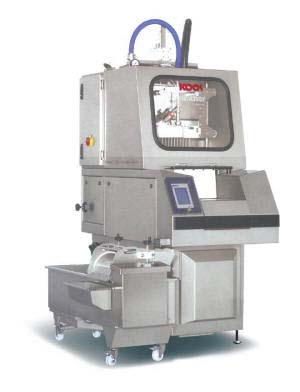
Brine injecting machine. Courtesy Koch Equipment, Kansas City MO
Adding sugar
Sugar is NOT a curing agent; its main use is to offset the harshness of salt and to further improve flavor and final color. It is well known that fruits preserved with sugar keep well for a long time when sealed in jars (canning). Sugar is added to brine in small amounts as it easily becomes food for numerous bacteria, which can multiply. With no sugar present, those bacteria will feed on protein. Another benefit is that sugar helps to develop the color. It does that indirectly by providing food (sugar) to color-forming bacteria that are present in meat. Sugar also acts also as an anti-oxidant. What it means is that it reacts easily with oxygen and prevents the latter from changing the color of the meat.
Too much sugar combined with long curing time can trigger fermentation. Now our brine or sweet pickle goes into a complicated but quiet fermentation process. Many other technologies rely on the fermentation process (baking bread, making wine), and curing is somewhat similar. When making wine, we mix yeast (bacteria) with water, and we add sugar (food for yeast) to start and maintain fermentation.
Curing solution should remain at temperatures no higher than 41° F (5° C). Otherwise, sugar will facilitate rapid fermentation and the development of meat-spoiling microorganisms, which is what we were trying to avoid in the first place. Even at low temperatures, the addition of sugar to wet cure should be limited to 2 % (in relation to salt) or less as it may start rapid fermentation, which may affect the quality of the product. Normally it is accepted to use between 1-2 % of sugar in a wet curing solution and 2-2.5 % of sugar in a dry cure mix. It does not really matter much whether white or brown sugar is used. Sugars commonly used in meat curing are beet, cane, and corn. Molasses and syrups have also been used. Keep in mind that different sugars will have different degrees of sweetness. Honey is often added to lean meats (ham) or even bacon for a distinctive flavor.
3 % of sugar in relation to salt is the commonly accepted figure. We have looked at a number of professionally written Meat Technology books by notable experts in the field and found that very little sugar (below 3 % in relation to salt) was used in curing solutions. For example, in American classical dry mix mixture: 8 lbs salt : 3 lbs sugar : 3 ozs potassium nitrate – the percentage of sugar in relation to salt is: 3 lb sugar/8 lb salt and that comes to 37%.
The books we have examined were:
- Meat Product Technology by M.D. Ranken (English Book)
- Meat Technology and Making Meat Products (Technologia Mięsa i Produktów Mięsnych) – A.A. Manergerger and E.J. Mirkin (Russian Book)
- Meat Technology (Technologia Mięsa) – Adam Olszowski, Ph.D (Polish Book)
- Meat Technology (Przetwórstwo Mięsa) – Władysław Poszczepczyński – Polish Book
- Meat Through the Microscope – C. Robert Moulton, Ph.D and W. Lee Lewis, Ph.D, The University of Chicago
In all those professional books, the amount of sugar in relation to salt was always below 5%. In Polish and Russian books, the ratio was 3% or less. As you can see, adding sugar is a matter of your personal choice, many curing solutions don’t employ sugar at all.
The sugar commonly used in curing is cane or beet sugar, also known as “sucrose”. Sometimes other sugars, syrups, and molasses are used and they all have a different chemical composition. Very popular is light-colored and well refined sugar called “cerelose dextrose”, also known as glucose. Keep in mind that dextrose (corn sugar) contains less sugar than cane or beet sugar and obviously tastes less sweet. A sugar found in raisin syrup and in honey is known as “fructose” , sometimes called levulose. There is a sugar called “lactose” in powdered milk products. Under certain conditions, the sucrose (common sugar) can be split into two sugars of equal proportions:
Sucrose (12 carbon atoms) = dextrose (6 carbon atoms) and levulose (6 carbon atoms).
Which Sugar is the Best?
The answer is very simple: there is no significant difference. There is no difference between cane and beet sugar when used for curing. Dextrose (corn sugar) is a reducing sugar and it is most effective in cures calling for short curing times (up to 15 days) as it reduces undesirable pigments in the meat. It reacts with those pigments and prevents them from changing the color of the meat. As it contains less sugar than other types, less of it remains in brine after 10 days and its curing properties are somewhat inhibited. Fructose sugar (honey) is also a reducing sugar and exhibits the same properties. Unfortunately it is too expensive to be of practical use. It is sometimes used by home sausagemakers to make a dry cured bacon as it imparts a peculiar flavor.
Sucrose (common cane and beet sugar) is not a reducing sugar but after about 10 days in a pickle it starts to break down into dextrose and fructose (levulose) and is most effective at long curing times. For all purposes curing and sweetening the common refined sugar is the best choice. Partially refined sugar (Grade 2) will cure meats as good as others and may be of interest to commercial establishments as its price will be lower.
Note: dextrose is much heavier than plain sugar and is only 70 % as sweet as regular sugar. It is a good choice when curing solutions contain potassium nitrate and is the preferred sugar for making traditional salami.
How Much Sugar?
If we decide to choose 3 % sugar in relation to salt, all we need is a calculator. For example, we choose 60 degree brine and in the table Column 3 calls for 1.567 lbs of salt to be added to 1 gallon of water. All we have to do is multiply 1.567 by 0.03 (3 %), and the result is: 1.567 x 0.03 = 0.047 lbs of sugar = 0.752 oz = 21 g = 4 tsp.
Oversalting can easily make a product not edible, but sugar is very forgiving, and you can always eat your meat-cake. The percentage used (3 %) is ten times smaller than the amount of sugar (37 %) that has been present in the American mix (8:3:3) for 100 years. Customers prefer many products on the sweet side: honey-flavored ham, honey-flavored bacon or poultry and ribs. Sugar is a flavoring agent, it does not cure meat directly, and the amount you want to use is up to you.
Spices and Vinegar
Spices are used in curing meats for the flavor they impart. It is known that the oils contained in spices can inhibit bacterial growth. To be of any use, they will have to be in very high concentration, and even then, they can not be used alone in curing. There was a myth a few centuries ago that when some highly flavored spices like saffron, marjoram, curry and others were added to recipes, the meats kept well. The fact is that they only helped to mask the odor of the slowly decomposing meats making them acceptable for consumption. It is like putting on perfume instead of taking a shower. Now you know why some countries like to use a lot of strong spices. In hot climates, people use a lot of hot peppers, not even knowing why. Eating hot food (peppers) makes your body sweat all over, and it gets cooled at the same time. For a guy sitting under a palm tree and without access to electricity, the only means to cool down is to keep on eating hot peppers and drinking beer.
Pepper is basically added for flavor. It has no value as a preservative and has little effect when added to brine cures since it can not dissolve in water. But it can be rubbed on the meat after curing or smoking, adding some flavor.
Vinegar is very effective in preventing the growth of bacteri, as most bacteria do not like acidy environments. Vinegar also adds flavor to the product and is commonly used in marinades and barbecue sauces.
Bad Brine Symptoms
- White slime and foam on top
- Milky color and foul odor
- Brine turns blue in color
- Brine becomes very tacky (gluey) to touch
It is normal for a thin scum or white mold to accumulate on top of the brine. This white foam should be periodically removed. In case the foam starts to give a foul odor, turn blue in color, or become much thicker slime, we have to remove the ham, wash it in cool water, and place it again in freshly made brine. At the first suspicion of brine spoilage it should be replaced with a fresh one, in most cases there is nothing wrong with the meat itself which should be just rinsed. Bad brine was nicknamed “ropy” pickle and was stringy, sticky, or slimy dripping from the fingers like syrup. Cured meats should be completely immersed in brine and weighted down when necessary. Most importantly no meat should protrude from the brine as it may get spoiled and then ruin the whole brine.
If brining a large amount of meat, pack them together in a barrel without using excessive force. Place heavy pieces like hams and shoulders on the bottom lighter ones like bacon on the top. Then, pour in the prepared solution covering all pieces. As the meats start to shift and may come to the surface, place a suitable clean weight on top to prevent them from contact with the air, as this can spoil the brine. Pack meats the skin side down. The container should be placed preferably in a refrigerator or a cool, well-ventilated place.
Reusing brine
Reusing brine at home conditions is a bad idea as the old brine could have some bacteria from the previous use. Besides, cure mixes are so inexpensive that it makes no sense to take the risk of meat contamination. We would like to mention that in the past, reusing curing solutions was popular and even helped to acquire good color, taste, and flavor much faster. It also helped to prevent a loss of meat juices and minerals that occurred during curing. However, the previously used curing solution was weaker, and more salt and nitrites had to be added. That requires professional testing and even if used, should be reserved for commercial meat plants.
Baumé Scale
You may come across a scale in Baumé degrees that is based on the specific gravity of the brine measured with a hydrometer. It is a popular scale in metric countries. One can measure the gravity of the brine with a specially designed float (like a brine tester); refer to the table and look up the % NaCl (salt) by weight. We have compiled a table that compares brine strength degree with Baumé scale.
| Specific Gravity | % NaCl (Salt) by Weight | Baumé Degrees | Salometer Degrees |
|---|---|---|---|
| 1.007 | 1 | 1.0 | 4 |
| 1.014 | 2 | 2.0 | 8 |
| 1.022 | 3 | 3.1 | 12 |
| 1.029 | 4 | 4.1 | 15 |
| 1.037 | 5 | 5.2 | 19 |
| 1.044 | 6 | 6.1 | 25 |
| 1.051 | 7 | 7.0 | 27 |
| 1.058 | 8 | 7.9 | 30 |
| 1.066 | 9 | 8.9 | 34 |
| 1.073 | 10 | 9.8 | 37 |
| 1.081 | 11 | 10.9 | 41 |
| 1.089 | 12 | 11.9 | 46 |
| 1.096 | 13 | 12.7 | 50 |
| 1.104 | 14 | 13.7 | 54 |
| 1.112 | 15 | 14.6 | 57 |
| 1.119 | 16 | 15.4 | 61 |
| 1.127 | 17 | 16.3 | 65 |
| 1.135 | 18 | 17.2 | 69 |
| 1.143 | 19 | 18.1 | 72 |
| 1.151 | 20 | 19.0 | 76 |
| 1.159 | 21 | 19.9 | 80 |
| 1.168 | 22 | 20.9 | 84 |
| 1.176 | 23 | 21.7 | 88 |
| 1.184 | 24 | 22.5 | 92 |
| 1.192 | 25 | 23.4 | 95 |
| 1.201 | 26 | 24.3 | 99 |
Salt Tables for UK gallons - UK gallon holds 4.54 liters
One Baumé degree corresponds to 10 g of salt in 1 liter of water.
Making brine by using floating egg method
Floating egg is an old traditional trick to measure the strength of the brine. Why do people make brine using eggs as a measuring device? In some countries, it is not an easily obtainable item; some people do not know it exists and others don't want to buy it. Salinometer is made of glass and can break at any time. Though an egg does not provide accurate readings it at least can help in case of an emergency. As there is no reliable information on how the egg behaves when immersed in brine we have decided to research the matter ourselves.
Conclusion
Between 10º and 20º degrees, the eggs lay on the bottom. At 30º degrees, they attempted to rise when touched with fingers. The first ones to rise off the bottom were X-Large White and Large-Brown at 35º degrees. They were also the first ones to break the surface at 40º degrees. The most defined point 45º degrees when all eggs swam to the surface.
To calculate the strength of the brine using the floating egg or potato method makes very little sense as the readings are not reliable. Some books advocate this method, and each of them gives different readings. The egg sinks in clean water, and as the salt is added, it starts lifting to the surface. Well, the eggs sink and float, but in an unpredictable manner. We have checked the floating egg method using five different sizes of fresh eggs, and the results were inconclusive.
Some sources say that at 80 degrees brine, the egg barely floats on the surface.
More information on making brine can be found in hams
Useful Information
- The 100 degrees brine (saturated) equals 26.4 % salt and a useful formula for calculating the percent salt in brine is to multiply the salimeter (brine tester) reading by 26.4 percent.
- For example, the percent salt in 60 degrees brine is: 60 x 26.4 percent (0.264) = 15.84 percent salt in brine.
- When doing those calculations, we can ignore the influence of the water temperature on salt. The reason being the fact that there is very little difference for the amount of salt to dissolve at different temperatures, for example at 32 F (0 C) 26.2 % of salt makes a saturated solution, and at 212° F (100° C) about 28.9 % salt will dissolve in water.
- Baking soda was sometimes used in small quantities to sweeten brine, or to recondition it. Adding a small amount of baking soda (1 Tablespoon (18 g) to 25 lbs of meat) to brine in warm weather was known to prevent it from spoiling.
- For pumping solution, it is advisable to have a reading of 70 – 85°, quite salty.
- For cover solution, the solution might be reduced to 55 – 65° as the meat will be immersed in it for longer time.
- Pumped at 10% of meat’s weight means a 10 lbs. ham requires 1 lb. of brine solution.
- Amount of water needed for making brine – about 40% of the meat weight.
- Recommended wet curing temperatures 36 – 40° F ( 2 – 5° C) at 90 – 95 % humidity.
- Salt dissolves much faster in hot water and that is why some people boil wet brine, then clarify it, and refrigerate it one day before intended use.
- It is advisable to place the meat on a scale when pumping to control the amount of pumped in brine.

